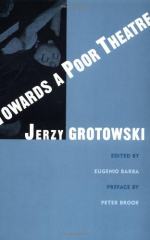
|
| Name: _________________________ | Period: ___________________ |
This test consists of 15 multiple choice questions and 5 short answer questions.
Multiple Choice Questions
1. The body should appear how in the warm-up exercises from "Actor's Training (1959 - 1962)"?
(a) Focused.
(b) Leaden.
(c) Restrained.
(d) Weightless.
2. Section B of "Actor's Training (1959 - 1962)" are titled _____.
(a) Voice Exercises.
(b) Plastic Exercises.
(c) Animal Exercises.
(d) Warm-Up Exercises.
3. Grotowski states in "The Actor's Technique" that when he first begins work with an actor his first question is "Does this actor have any _____ difficulties?"
(a) Breathing.
(b) Physical.
(c) Intellectual.
(d) Emotional.
4. The first explanation of the "Shoulderstand exercises" is _____.
(a) How to stand.
(b) How to fall.
(c) How to relax.
(d) How to jump.
5. In "Actor's Training (1966)", it is noted that Grotowski mentions that contact between the audience and actor is _____ in the theatre.
(a) Unnecessary.
(b) Destructive.
(c) Detrimental.
(d) Vital.
6. In "Dr. Faustus", the spectators are _____.
(a) The actors.
(b) The animals.
(c) The guests.
(d) The prisoners.
7. What does Grotowski begin with in "Actor's Training (1966)"?
(a) Animal exercises.
(b) Jumping exercises.
(c) Floor work.
(d) Vocal exercises.
8. Section B of "Actor's Training (1959 - 1962)" are based upon the work of _____.
(a) Dellarte.
(b) Sauterne.
(c) Stanislavski.
(d) Dalcroze.
9. Grotowski in "The Actor's Technique" says that in understanding how he differs from Stanislavski, Brecht, and Artaud that it is important to distinguish between aesthetics and _____.
(a) Beauty.
(b) Methods.
(c) Activities.
(d) Theories.
10. Grotowski points out in all of his lessons in "Actor's Training (1966)" that _____ must be excluded in the exercises.
(a) Gravity.
(b) Thought.
(c) Connection.
(d) Feeling.
11. What is the first exercise in "Warming Up" from "Actor's Training (1959 - 1962)"?
(a) Rhythmical walking while arms and hands rotate.
(b) Running on tiptoe.
(c) Walk with knees bent, hands on hips.
(d) Walk with knees bent, gripping the ankles.
12. What part of the body does Grotowski call the "center of expression" in "Actor's Training (1966)"?
(a) The feet.
(b) Vertebral column.
(c) The heart.
(d) The skull.
13. Grotowski says in "American Encounter", that "we cannot hide our personal, essential things--even if they are _____."
(a) Sins.
(b) Impulses.
(c) Ugly.
(d) Scary.
14. How many types of respiration are there, as noted by Grotowski in "Actor's Training (1959 - 1962)"?
(a) Four.
(b) Five.
(c) Two.
(d) Three.
15. Grotowski claims in "Skara Speech" that our whole body is a system of _____.
(a) Thoughts.
(b) Resonators.
(c) Sensation.
(d) Emotions.
Short Answer Questions
1. Grotowski states in "Skara Speech" that memories are always _____.
2. Grotowski states in "The Actor's Technique" that it is a fact that children, animals, and people who are close to nature breathe _____.
3. In "American Encounter" Grotowski states that the process of getting self-knowledge gives _____ to one's work.
4. The notes of "Actor's Training (1966)" were taken by _____.
5. The one absolute rule Grotowski cites in "Actor's Training (1966)" is that what must come first, then vocal expression?
|
This section contains 421 words (approx. 2 pages at 300 words per page) |

|




